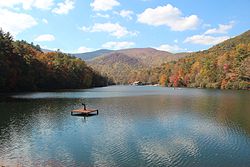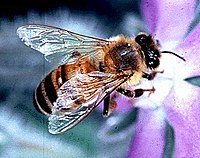Portal:Georgia (U.S. state)
The Georgia (U.S. state) PortalGeorgia /ˈdʒɔːrdʒə/ is a state located in the southeastern United States. It was established in 1732, the last of the original Thirteen Colonies. Named after King George II of Great Britain, Georgia was the fourth state to ratify the United States Constitution, on January 2, 1788. It declared its secession from the Union on January 21, 1861, and was one of the original seven Confederate states. It was the last state to be restored to the Union, on July 15, 1870. Georgia is the 24th most extensive and the 8th most populous of the 50 United States. From 2007 to 2008, 14 of Georgia's counties ranked among the nation's 100 fastest-growing, second only to Texas. Georgia is known as the Peach State and the Empire State of the South. Atlanta is the state's capital and its most populous city. Georgia is bordered on the south by Florida; on the east by the Atlantic Ocean and South Carolina; on the west by Alabama; and on the north by Tennessee and North Carolina. The northern part of the state is in the Blue Ridge Mountains, a mountain range in the vast Appalachian Mountains system. The central piedmont extends from the foothills to the fall line, where the rivers cascade down in elevation to the continental coastal plain of the southern part of the state. The highest point in Georgia is Brasstown Bald, 4,784 feet (1,458 m); the lowest point is the Atlantic Ocean. Georgia is the most extensive state east of the Mississippi River in terms of land area, although it is the fourth most extensive (after Michigan, Florida, and Wisconsin) in total area, a term which includes expanses of water which are part of state territory.
Selected article -Hurricane Babe was the second named storm and the first to impact the United States during the below-average 1977 Atlantic hurricane season. Forming out of a tropical wave on September 3, Babe began as a subtropical cyclone in the eastern Gulf of Mexico. The storm gradually intensified as it tracked westward. On September 5, the storm turned north and acquired enough tropical characteristics. Later that day, Babe intensified into a hurricane and attained its peak strength with winds of 75 mph (120 km/h) and a barometric pressure of 995 mbar (hPa; 29.38 inHg). Several hours later, the hurricane made landfall in Louisiana and quickly weakened. By September 6, Babe had weakened to a tropical depression and later dissipated early on September 9 over North Carolina. Hurricane Babe produced minimal impact throughout its path in the United States. The most significant impact occurred in Louisiana where the storm caused $10 million (1977 USD; $50.3 million 2024 USD) in damage, mainly from crop losses. An additional $3 million (1977 USD; $15.1 million 2024 USD) in losses resulted from tornadoes spawned by Babe. Heavy rainfall in North Carolina, peaking at 8.99 in (228 mm) triggered flash flooding but little damage. No fatalities resulted form the hurricane. Selected picture - Credit: Thomson200
Vogel State Park is a 233-acre (0.94 km2) or 94 hectares state park located at the base of Blood Mountain in the Chattahoochee National Forest. It became one of the first two parks in Georgia when it founded a state park system in 1931. Much of the park was constructed by the Civilian Conservation Corps during the 1930s. State facts
State symbols:
Selected biography -Wadsworth Aekins Jarrell is an African-American painter, sculptor and printmaker. Born in Albany, Georgia, he moved to Chicago, Illinois, where he attended the Art Institute of Chicago. After graduation, he became heavily involved in the local art scene and through his early work he explored the working life of blacks in Chicago and found influence in the sights and sounds of jazz music. In the late 1960s he opened WJ Studio and Gallery, where, along with his wife, Jae, he hosted regional artists and musicians. Mid-1960s Chicago saw a rise in racial violence leading to the examination of race relations and black empowerment by local artists. Jarrell became involved in the Organization of Black American Culture, a group that would serve as a launching pad for the era's black art movement. In 1967, OBAC artists created the Wall of Respect, a mural in Chicago that depicted African American heroes and is credited with triggering the political mural movement in Chicago and beyond. In 1969, Jarrell co-founded AFRICOBRA: African Commune of Bad Relevant Artists. AFRICOBRA would become internationally acclaimed for their politically themed art and use of "coolaid colors" in their paintings. Jarrell's career took him to Africa in 1977, where he found inspiration in the Senufo people of Nigeria. Upon return to the United States he moved to Georgia and taught at the University of Georgia. In Georgia, he began to use a bricklayer's trowel on his canvases, creating a textured appearance within his already visually active paintings. The figures often seen in his paintings are abstract and inspired by the masks and sculptures of Nigeria. These Nigerian arts have also inspired Jarrell's totem sculptures. Living and working in Cleveland, Jarrell continues to explore the contemporary African American experience through his paintings, sculptures, and prints. His work is found in the collections of the National Museum of African American History and Culture, High Museum of Art, The Studio Museum in Harlem and the University of Delaware. Selected anniversaries for May
Did you know -
CategoriesSelect [►] to view subcategories
WikiProjects
What are WikiProjects? Selected panoramaCredit: Jim
Forsyth Park is a large city park that occupies 30 acres (0.12 km2) in the historic district of Savannah, Georgia. The park is bordered by Gaston Street on the North, Drayton Street on the East, Park Avenue on the South and Whitaker Street on the West. It contains walking paths, a Cafe', a children's play area, a Fragrant Garden for the Blind, a large fountain, Tennis courts, BasketBall courts,areas for soccer/frizbee, and home field for Savannah Shamrocks Rugby Club. From time to time, there are concerts held at Forsyth to the benefit of the public. Selected quoteQuality content
Featured articles
Featured lists
Featured pictures
TopicsThings you can doedit · history · watch · purge Related portalsAssociated WikimediaThe following Wikimedia Foundation sister projects provide more on this subject:
Discover Wikipedia using portals |




























